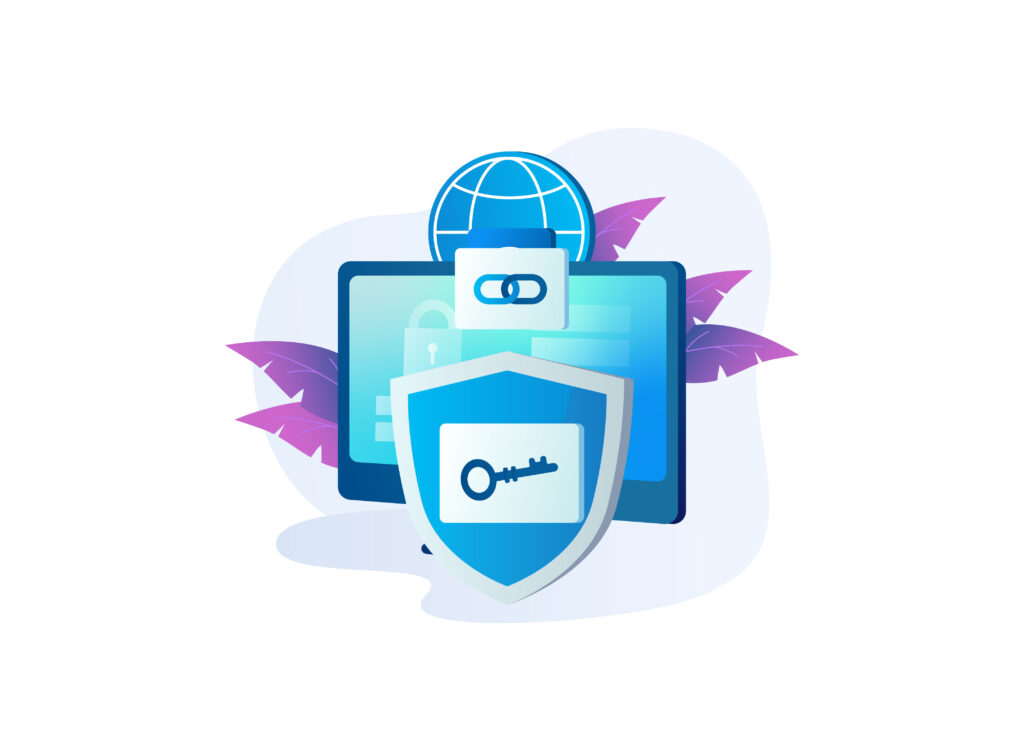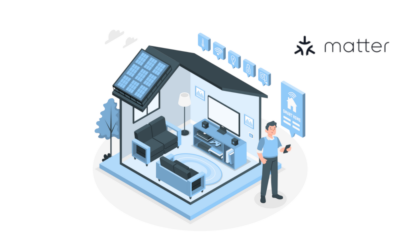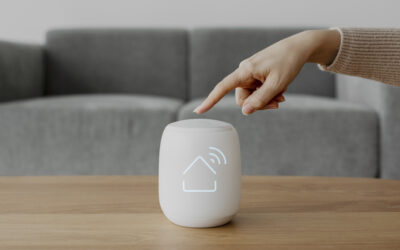Table of Content
- Recommended Baseline IoT Product Criteria
- Connecting IoT Vulnerabilities with Criteria
- Recommended Outcome-Oriented Criteria for IoT Products
- What is the U.S. Cyber Trust Mark?
- Scheme Owners’ Vital Role in the Labeling System
- Harmonization of IoT Product Labeling Program
- Labeling Recommendations
- Consumer Education About U.S. Cyber Trust Mark Program
- Conformity Assessment
- Cybersecurity Efforts by IoT Industry Players
- Krasamo IoT Development
As more of our daily interactions become mediated through IoT devices, ensuring the security of these devices and the personal data they manage has become increasingly pressing. This necessitates formulating a comprehensive cybersecurity strategy to protect consumers and their data from potential threats.
In response to this, the National Institute of Standards and Technology (NIST), under the directive of Executive Order 14028, “Improving the Nation’s Cybersecurity,” initiated the development of criteria for a cybersecurity labeling program, the U.S. Cyber Trust Mark, specifically designed for consumer IoT products that are expected to be running by late 2024.
The U.S. Cyber Trust Mark consumer IoT labeling program is built on the existing NIST 8425, NISTIR 8259A, and NISTIR 8259B publications.
This voluntary labeling program is designed to provide consumers with clear and understandable information about the security of IoT products, allowing them to make informed decisions. In addition to helping consumers, the program aims to incentivize manufacturers to prioritize the development of cyber-secure products (secure by design).
NIST has created a recommended baseline product criteria for this labeling scheme based on its existing work in IoT cybersecurity, international standards, and a thorough review of recent IoT product vulnerabilities. However, it should be noted that NIST is not creating its own scheme but is instead identifying key elements of a potential labeling scheme that another organization could implement.
The responsibility of managing the labeling scheme (including tailoring product criteria, developing the label and associated information, and overseeing its application) falls to the scheme owner. The ultimate goal is to create an IoT unified labeling program that reduces confusion among consumers and promotes the widespread adoption of rigorous security practices in the IoT sector.
Recommended Baseline IoT Product Criteria
A consumer IoT product often encompasses a complex system of components, from the endpoint devices to backend servers and companion applications, each of which contributes to the product’s overall functionality. However, these components also present potential avenues of vulnerability and cyber-attack. Therefore, it is paramount that the entire IoT product, including all auxiliary components, is secured and safeguarded against cyber threats.
NIST’s recommended criteria cater to this wide array of components and their potential vulnerabilities. For instance, each IoT product should have the ability to be uniquely identified and maintain an updated inventory of all its constituent components. Furthermore, the IoT product’s configuration should be changeable, with a secure default setting that can be restored when needed, and only authorized individuals should be able to effect these changes.
In the data context, NIST emphasizes that all stored and transmitted data should be protected from unauthorized access, disclosure, and modification. This includes data within individual IoT components and data transmitted between or outside the product. Moreover, the IoT product should restrict logical access to local and network interfaces and protocols and services used by those interfaces to only authorized individuals, services, and other IoT product components.
A labeling program highlights the importance of regularly updating the software across all IoT product components, using secure and configurable mechanisms. To aid in detecting cybersecurity incidents, it’s vital that IoT products not only maintain constant cybersecurity awareness but also systematically log relevant information regarding the status and activities of their components.
In addition to the product-focused criteria, some recommendations apply to IoT development engineers. Developers should maintain extensive documentation about the cybersecurity aspects of the IoT product and should be able to receive and respond to queries about the cybersecurity of the product. In the same vein, developers should disseminate and broadcast relevant cybersecurity information and work to educate customers about the cybersecurity features of their IoT products.
These recommended criteria outline a comprehensive approach to ensuring the cybersecurity of consumer IoT products, thereby enhancing consumer trust and promoting a secure IoT landscape. These guidelines encourage IoT developers to critically assess their products, identifying potential vulnerabilities and working to address them, aiming to create safer, more secure IoT devices.
Connecting IoT Vulnerabilities with Criteria
Given this diversity of vulnerabilities and corresponding attack tactics, there is no one-size-fits-all solution. Hence, the baseline criteria proposed by the IoT product labeling program are designed to mitigate certain risks associated with each vulnerability. These criteria are not prescriptive in terms of how the mitigations are achieved. Instead, they offer flexible guidelines for securing IoT devices while allowing for innovation and context-based customization.
Recommended Outcome-Oriented Criteria for IoT Products
- Product Configuration
- Interface Access Control
- Product Education and Awareness
- Cybersecurity State Awareness
- Data Protection
- Asset Identification
- Information Dissemination
- Software Update
- Documentation
- Information and Query Reception
By analyzing vulnerabilities, associated attack tactics, and related baseline criteria of many use cases, we can learn and work to develop secure IoT products.
For instance, use cases of unauthorized access, exposure to the internet, and unencrypted sensitive data vulnerabilities led to the exploitation tactics such as privilege escalation, credential access, and data collection. Relevant baseline criteria to mitigate these risks include product configuration, interface access control, product education and awareness, and cybersecurity state awareness.
Similarly, an attack demonstrating weak authentication and lack of internal configuration controls led hackers to use techniques like initial access through valid accounts, execution through command and scripting interpreter, and privilege escalation. The related baseline criteria could be asset identification, interface access control, information dissemination, software update, and cybersecurity state awareness.
The unauthorized access and publication of mobile app data with vulnerabilities in web application security, unsecured data storage, and weak de-identification methods with corresponding attack tactics (Initial Access through exploit public-facing application, persistence through code injection, and privilege escalation) and criteria to mitigate vulnerabilities (product configuration, cybersecurity state awareness, data protection, and documentation)
Looking at these patterns, the importance of the relationship between various vulnerabilities, attack techniques, and baseline criteria becomes evident. This interplay forms the core of understanding how to secure your devices and IoT ecosystems. It also emphasizes the importance of focusing on technological solutions and user awareness and education to ensure the cybersecurity of IoT devices.
What is the U.S. Cyber Trust Mark?
It’s vital that these criteria directly address the risks they are meant to mitigate, effectively guiding developers or assessors in their application to specific products or components.
Scheme Owners’ Vital Role in the Labeling System
The scheme owner is the organization or entity responsible for managing and overseeing this scheme. This could be either a public or private sector organization. The scheme owner plays a pivotal role in deciding the scheme’s structure and management, ensuring its operations are aligned with its objectives.
The owner also tailors the product criteria, defines the conformity assessment requirements, develops the product labels and relevant information, and conducts consumer outreach and education.
A scheme owner plays an important role in ensuring that any IoT product meets the expected outcomes. When designing a consumer IoT labeling program, the scheme owner should consider risks related to the product, its components, the customer, and the community.
Additionally, they must contemplate appropriate risk mitigations and their implementation across product components. Tiers in product criteria can also be introduced, driven by the unique risks and needs associated with different IoT products and their components.
The scheme owner will be responsible for balancing these considerations to determine how best to apply the baseline criteria. Furthermore, the criteria for higher cybersecurity tiers could be defined by the inherent risk of the device type or its expected use case and by additional requirements and testing tools. To justify the product’s label, scheme owners must ensure there is enough evidence of conformity to the criteria.
The owner of an IoT labeling scheme can use any existing standard or program, align it with global IoT labeling programs, and employ it to fulfill specific product goals and criteria.
Harmonization of IoT Product Labeling Program
It’s crucial to carefully scope and harmonize the IoT product labeling program with others to prevent confusion, especially for IoT components like mobile apps. Harmonization provides clear direction for adopting cybersecurity and predictability across products, while fragmentation can lead to complications and potential confusion due to divergent requirements.
However, given the diverse nature of the consumer IoT market, complete harmonization may not always be feasible. Thus, when considering the degree of harmonization, a scheme owner should weigh the benefits of harmonization against fragmentation challenges.
Labeling Recommendations
The label’s influence on purchasing decisions depends on factors like time pressure, product functionality, availability of non-connected products, and cost. A good labeling program can educate consumers on the cybersecurity aspects of their IoT purchases.
Recommended labeling practices include:
- Using a binary labeling approach (Layered Binary Label) (a single label showing the product meets a standard) coupled with a layered approach (additional details accessible via URL or QR code). Consumers can obtain via QR code updated security information about their devices.
- Making the label available before, during, and after the point of purchase ensures its flexibility in physical and digital formats.
- Regular consumer testing assesses initial perceptions and purchases intent, and periodic testing after program implementation to gauge consumer behavior, label appropriateness, and brand recognition growth.
Note this does not cover specific design elements of the label but emphasizes the importance of its usability and understandability and regular consumer testing to avoid bias and ensure statistical relevance.
Consumer Education About U.S. Cyber Trust Mark Program
The responsibility for distributing information may fall on various parties, such as the label program administrator, IoT developers, retailers, manufacturers, security groups, academia, and the government, contingent upon the final structure of the labeling program.
It is viewed as essential for consumers to have online access, beyond just the label, to a range of information such as the intent and scope of the label, product criteria, a user-friendly glossary of technical terms, general information about conformity assessment, and the product’s specific declaration of conformity to the baseline criteria.
Careful attention to messaging and framing is key in formulating consumer education materials. A layered approach that provides basic information upfront, supplemented by more detailed information upon request, is recommended to cater to different levels of consumer engagement and understanding.
Conformity Assessment
This scheme outlines how conformity assessment tasks, roles, and outcomes are structured and managed. Whether a public or private entity, the scheme’s owner oversees its management and consistency with the overall objectives.
Given the diverse nature of consumer IoT products and the relative lack of applicable international standards, more than one conformity assessment approach is required. For consumers who struggle to evaluate the cybersecurity of an IoT device, conformity assessment plays a crucial role in providing them with understandable and actionable information about the product.
Different IoT activities can be employed to show that devices comply with technical requirements. These can include the supplier’s self-attestation, where the provider of the IoT device declares its conformity against a predefined set of criteria.
Alternatively, third-party testing or inspection can be used to examine the IoT device based on defined criteria. A third-party certification, based on an in-depth review, could also affirm that the IoT product meets specific criteria. The choice of activity, or combination of activities, depends on the product and the conformity requirements.
Cybersecurity Efforts by IoT Industry Players
Beyond the introduction of the Matter Certification by The Connectivity Standards Alliance (CSA) last October, the alliance has been working with governments and private companies on harmonizing and aligning leading standards and a certification model to provide coverage in their scheme.
The Connectivity Standards Alliance (CSA) has formed a Product Security Working Group, with 130+ companies (with strong support) is developing a global program for consumer IoT product security certification that aligns with government standards and regulations (NISTIR 8425 in North America, ETSI EN 303 645 in Europe, and ISO 27402), including the US Cybersecurity Label and other national certification schemes, to assure consumers worldwide of product security, prevent the need for duplicative testing and certification in different countries, and foster a strong security baseline for all devices.
Krasamo IoT Development
Our team of IoT engineers supports clients in adapting their products to IoT cybersecurity standards and certification schemes (requirements) and certification programs (process to verify a product meets requirements), harmonization efforts, and regulations.












Kudos on shedding light on the emerging IoT cybersecurity labeling landscape! The U.S. Cyber Trust Mark initiative is a step towards harmonizing standards & ensuring consumer trust – exciting times ahead for IoT security labeling and iotcybersecuritylabeling!